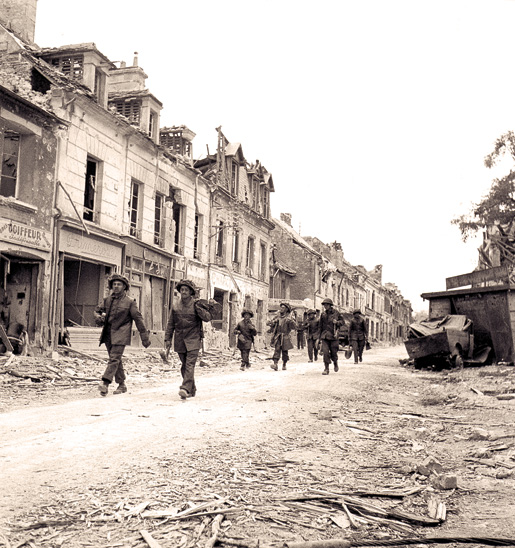![June 6, 1944. [PHOTO: GILBERT ALEXANDER MILNE, LIBRARY AND ARCHIVES CANADA–PA122765]](https://legionmagazine.com/wp-content/uploads/2009/04/ddayintro.jpg)
The following timeline on the D-Day invasion and Normandy Campaign represents a rough sketch of how the fighting progressed during the summer of 1944. More specific details can be found in many fine books on the subject.
August 1943: The plan to invade France is endorsed during the Quebec Conference attended by Prime Minister William Lyon Mackenzie King, Winston Churchill and Franklin Delano Roosevelt.
![August 1943. [PHOTO: NATIONAL FILM BOARD/LIBRARY AND ARCHIVES CANADA]](https://legionmagazine.com/wp-content/uploads/2009/04/timelineaug43.jpg)
May 8, 1944: General Dwight D. Eisenhower settles on June 5, 1944, as the date of the cross-Channel Normandy invasion. It is also decided that in the event of bad weather, the invasion could be mounted on June 6 or 7.
May 26, 1944: Amid tight security and great secrecy, Canadian, British and American forces are concentrated on the south coast of England. The camps are sealed and no one can enter or leave without special authorization.
![June 4, 1944. [GILBERT ALEXANDER MILNE, LIBRARY AND ARCHIVES CANADA–PA115614]](https://legionmagazine.com/wp-content/uploads/2009/04/timelinejun4.jpg)
June 4, 1944: Thousands of military personnel begin to embark on ships, but the weather takes a nasty turn and the invasion is postponed.
June 5, 1944: The massive invasion force begins to cross the English Channel, heading for the Normandy coast.
June 6, 1944: Two years after the disastrous raid at Dieppe and four years after the evacuation at Dunkirk, the Allies are returning to France. In the very early hours, airborne divisions jump or glide down onto the flanks of the invasion areas to seize key bridges and road junctions. More than 7,000 vessels participate in the invasion fleet which is covered by aircraft from some 170 squadrons. The main invasion force lands on five sectors or beaches codenamed (from west to east) Utah, Omaha, Gold, Juno and Sword. It is a five-division front spread over 80 kilometres along the Normandy coast. By day’s end, the Allies land more than 130,000 men and almost 6,000 vehicles by sea. Another 23,400 are landed by air. Total casualties are about half of the 20,000 feared.
![June 7, 1944. [DONALD I. GRANT, LIBRARY AND ARCHIVES CANADA–PA129042]](https://legionmagazine.com/wp-content/uploads/2009/04/timelinejune7.jpg)
June 7, 1944: The 12th SS Panzer Division launches a major and bloody counterattack against the Canadians. German stability is restored temporarily.
June 17, 1944: Hitler makes a quick visit to France. Field marshals Erwin Rommel and Gerd von Rundstedt inform him that the Allies cannot be driven out of France. Their assessment of the situation is repeated on June 29.
June 19, 1944: Two massive and brilliantly designed artificial harbours—codenamed Mulberries—are nearing completion when a gale causes extensive damage. The one being built for the Americans at St. Laurent, Normandy, is abandoned, but the other one, built for the British and Canadians at Arromanches, survives. Once operational, it handles up to 11,000 tons of supplies a day. Built in sections at locations around the United Kingdom and then towed across the English Channel and sunk, the Mulberries mean the Allies don’t have to rely on existing port facilities in France. Thousands of men and more than 130 tugs are used during assembly.
June 30, 1944: American forces capture the Channel port of Cherbourg and the tip of the Cotentin peninsula.

July 7, 1944: Allied bombers cause extensive damage to the city of Caen. British and Canadian troops get into the streets. The Germans retreat from the northern part of the city and set up defensive positions across the Orne River. Caen is soon liberated.
July 18-20, 1944: Fierce German resistance stops Allied progress during the drive to the plain between the cities of Caen and Falaise further to the south.
July 23, 1944: First Canadian Army assumes control of the easternmost part of the Allied front.
July 30, 1944: American forces seize Avranches on the west coast of the Cotentin peninsula and, after withstanding a counterattack, capture a bridge at Pontaubault. The bridge helps pave the way to Brittany, southwards to the River Loire and eastwards to the River Seine.
Aug. 1, 1944: Patton’s Third U.S. Army enters the campaign on the westernmost part of the Allied front. With the exception of a narrow corridor near Avranches, the enemy is holding firm, but confidence is slipping among senior commanders in Normandy. Nevertheless, Hitler directs them to prepare a large-scale offensive to regain Avranches.
Aug. 8, 1944: South of Caen and on the heels of a heavy aerial bombardment, First Canadian Army mounts a massive and well-planned armoured attack and, in the process, moves closer to Falaise.
A plan is hatched by the Allies to form a pocket with the possibility of trapping 21 German divisions west of Falaise and Argentan.
![August 16, 1944. [KEN BELL, LIBRARY AND ARCHIVES CANADA–PA145557]](https://legionmagazine.com/wp-content/uploads/2009/04/timelineaug16.jpg)
Aug. 16, 1944: Canadians fight their way into Falaise. Soon, most of the German forces in Normandy (between 150,000 and 200,000 men) are trapped in a pocket. Thousands of Germans manage to escape as the opening in the pocket is closed even tighter. In a few days the gap will be firmly shut and the enemy will be either defeated or on the run.
Email the writer at: writer@legionmagazine.com
Email a letter to the editor at: letters@legionmagazine.com
Advertisement






















